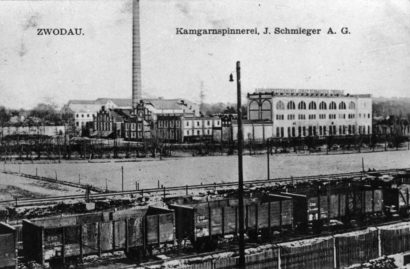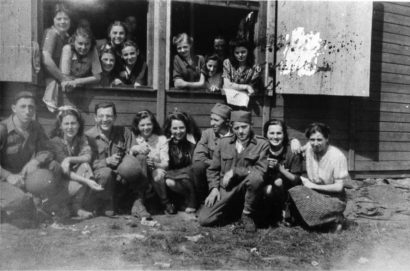Zwodau (Svatava) Subcamp
December 1943 – April 20, 1945
Starting September 1, 1944, under the authority of the Flossenbürg concentration camp
![]()
View of the Ignaz Schmieger fabric mill in Zwodau, 1920's (Theresienstadt Memorial)
![]()
Liberated prisoners of the Zwodau subcamp with American soldiers, 1945 (Theresienstadt Memorial)
-
Prisoners
Of the 1,350 registered women, 435 were Hungarian (of which 235 were Jews, the others Sinti and Roma), 279 Germans, 265 French, 158 women from Poland, 121 from the Soviet Union, 46 from Yugoslavia, along with Czech and Dutch woman.
-
The highest number at one time was 750 women (end of June 1944).
-
Forced labor and quarters
Construction of the camp where the women were quartered. The barracks compound was fenced-in, the way to the factory was also fenced off.
-
In the disused fabric mill Ignaz Schmieger, the women were forced to build reels, switches, and measuring instruments for the Siemens subsidiary, Luftfahrtgerätewerk Hakenfeld, an aeronautical equipment company
-
Guards
25 SS men, 21 female overseers. Both the detail leaders Kurt Erich Schreiber (until mid-February 1945) and Willi Jordan, as well as the head overseers Schneider and Anneliese Unger, were accused of brutal mistreatment, incidents of which resulted in death of prisoners.
-
Death toll
50 instances of death are documented. In April 1945, more than 1,000 women arrived on evacuation marches from other subcamps. An unknown number of these women died in Zwodau.
-
Disbanding of the camp / end of the war
On April 20, 1945, the camp was evacuated. After a three-day march, the SS forced the women to turn around and head back to the largely destroyed camp. The women were liberated there by American troops on May 7, 1945.
-
Commemoration
An exhibition on the camp’s history, originally located in one of the barracks, can now be seen in the Sokolov District Museum.
-
A gravesite for the prisoners, laid out by the allied troops, and a monument from the time of the Czechoslovak Socialist Republic (CSSR) memorializes the subcamp.

